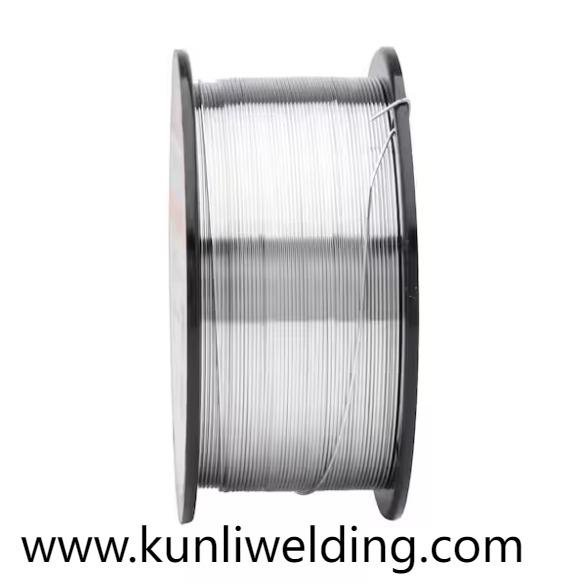Kunliwelding: What questions should you ask China Aluminum Mig Wire Manufacturers?

When procurement teams look to global sources for consumables, Aluminum Mig Wire Manufacturers in China are often considered for their production scale and variety. Selecting the right partner requires a mix of commercial discipline and technical rigour so that coils delivered to the dock feed reliably and meet project expectations in the shop.
Start with paperwork and traceability. Ask for clear lot marking on each spool and a certificate that ties that marking to production checks. That traceability matters when a sample needs retesting or when you need to track a problem back to a specific run. Buyers who require lot linked paperwork save time during root cause work and reduce the argument overhead when a batch behaves differently from a prior shipment.
Packaging and transit protection are practical priorities. Coils that arrive with compromised packaging often carry moisture or surface marks that lead to porosity or feeding hiccups under live weld conditions. Specify moisture resistant wraps and protective spool covers, and require visible labels that match the paperwork. Returnable spool schemes are worth exploring for repeated orders because they reduce one way waste and can simplify handling when volumes justify the arrangement.
Pilot trials should be non negotiable for new suppliers or unfamiliar batches. A concise pilot script that mirrors your feeder geometry and joint type gives engineers and operators a realistic snapshot of feedability and bead profile before larger volumes are released. Include a short bench feed test and a termination sample so both feeder and finishing teams can validate settings. Capture photos and parameter notes so the pilot result becomes a reusable baseline for future lots.
Feeder compatibility is where many projects stumble. Aluminum wire requires smooth liners and matched spool adapters to avoid bird nesting. Validate feed paths during a pilot and keep spare liners and adapters on hand to handle variations between spool types. When a supplier supplies adapter dimensions or recommended liner specs, your set up time drops and stoppages become less likely.
Define acceptance and corrective terms in the purchase documents. Staged release language lets you accept a pilot quantity under agreed checks and release the remainder when results meet the documented criteria. Spell out remedies for nonconforming shipments including rework, replacement, or a retest procedure and who pays for return shipping. Clear contractual language reduces negotiation time when problems occur and makes resolution procedural rather than personal.
Technical support and responsiveness matter in the current sourcing environment. Suppliers that provide practical handling notes, recommended parameters, and rapid photo responses to arrival questions accelerate qualification. When global logistics become uncertain or freight patterns shift, suppliers that communicate early about delays or packing changes help procurement plan alternatives and avoid last minute production interruptions.
Sustainability and sourcing resilience are increasingly part of supplier assessment. Buyers now ask about scrap handling, whether the supplier reclaims clean offcuts, and how packaging is managed. These operational details can affect landed cost and supplier availability when transport windows tighten. Sellers who can outline practical recycling or spool return paths reduce administrative friction for customers who must report environmental or circularity metrics.
Quality control on the supplier side is visible in simple indicators. Ask for examples of batch paperwork, a description of alloy checking procedures, and a sample of in house inspection records. Even short run charts or basic checklists show whether a supplier treats process control as an ad hoc step or as integrated in production. That difference shows up in batch to batch consistency and the time you spend calibrating weld parameters on arrival.
Communication between procurement, engineering and the shop is essential. Share your pilot script with the supplier ahead of the first shipment so they can confirm packaging and recommend feeder notes. When both sides agree on a short acceptance checklist the pilot phase proceeds faster and both parties know the evidence needed for final release.
Operational habits in the shop help convert supplier competence into production reliability. Keep a simple arrival checklist that includes spool marking verification, packaging inspection, a bench feed test, and a termination sample. Archive the pilot photos and parameter notes with the supplier invoice so future acceptance is straightforward. Regular short training sessions on feeder set up and gas checks reduce the human factor variability that often magnifies supplier differences.
If you want a supplier that provides clear product notes and application guidance to support pilot trials, consider providers that publish handling advice and suggested settings for common joint types. Practical supplier materials reduce trial error and make qualification less time consuming. One useful resource for product information and handling guidance is the aluminum alloy wire product documentation available at https://www.kunliwelding.com/product/aluminum-alloy-wire/aluminum-alloy-welding-wire.html which includes application notes and handling recommendations you can adapt into your acceptance script.
Choosing a supplier is about more than price. By insisting on traceability, protective packaging, realistic pilot trials, clear contractual remedies, and prompt technical support you create a pathway from sample to steady supply that limits interruptions and protects schedules. That approach turns supplier selection into a measured procurement process rather than a gamble on unit price.
- Art
- Causes
- Crafts
- Dance
- Drinks
- Film
- Fitness
- Food
- Games
- Gardening
- Health
- Home
- Literature
- Music
- Networking
- Other
- Party
- Religion
- Shopping
- Sports
- Theater
- Wellness

